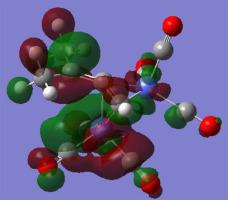Journal of Organometallic Chemistry ( IF 2.3 ) Pub Date : 2020-12-29 , DOI: 10.1016/j.jorganchem.2020.121667 Kenneth M. Nicholas

|
Propargyl-dicobalt carbonyl complexes (R1C2CR2R3)Co2(CO)6+Z− (2), first discovered nearly fifty years ago, have been extensively investigated and developed as useful reagents for propargyl-nucleophile coupling reactions. However, aside from early spectroscopic and semi-empirical theoretical studies, the structures, electronic properties and reactivity of these compounds have received scant attention using more rigorous computational methods. In this report a DFT analysis is presented of the structures, electronic character, stability, fluxionality and reactivity of two sets of propargyl complexes, the –Co2(CO)6 derivatives 2 and (R1C2CR2R3)Co2(CO)5(PZ3)+Z− (3), focusing on the effects of substituents and auxiliary ligands. The key findings include: 1) confirmation of their η2,η3-low temperature-limiting unsymmetrical structures; 2) that most substituents on the propargyl unit have relatively small effects on their stability, while auxiliary ligands of 3 can have substantial stabilizing effects; 3) calculated atomic charges, frontier MO analysis, IR and NMR spectra together indicate extensive electronic delocalization in 2 and 3, with a majority of positive charge dispersed onto the -Co2(CO)5,6(L) unit and a greater residual charge and LUMO character on C1 of the propargyl unit; 4) the latter factors account for the regioselective C-1 attack of nucleophiles on 2 and 3; 5) that two isomerization processes, enantiomerization and syn/anti diastereomerization, are viable via corresponding parallel and perpendicular transition states, the former generally being the lower in energy by ca. 2-3 kcal/mol); 6) that C-3 substituents on the propargyl unit, with one exception (R1=OR), have small effects on these isomerization barriers, as is case for electron-poor phosphines, e.g. L=PF3; 7) that stronger donor phosphines increase rigidity, stability and isomerization barriers, but non-linearly; and 8) that an alternative dynamic isomerization process, involving tetrahedral-to-planar squashing of the Co2C2 cluster, could be energetically accessible. Insights into the underlying factors causing these effects are presented along with some prospects for new reactivity and selectivity possibilities.
中文翻译:

的结构中,动态和反应性的DFT分析[(炔丙基)有限公司2(CO)5(L)] + ž -
炔丙基羰基二钴羰基复合物(R 1 c ^ 2 CR 2 - [R 3)有限公司2(CO)6 + ž - (2),第一近五十年前就发现,已被广泛地用于炔丙基亲核试剂偶联反应研究和作为有用试剂开发。然而,除了早期的光谱学和半经验理论研究以外,使用更严格的计算方法还很少关注这些化合物的结构,电子性质和反应性。在本报告中,DFT分析了两组炔丙基配合物–Co 2的结构,电子特性,稳定性,通量和反应性。(CO)6个衍生物2和(R 1 c ^ 2 CR 2 - [R 3)有限公司2(CO)5(PZ 3)+ ž - (3),着眼于取代基和配体辅助的效果。的主要结果包括:1)它们的η的确认2,η 3 -低温度限制不对称结构; 2)炔丙基单元上的大多数取代基对其稳定性的影响相对较小,而3的辅助配体具有很大的稳定作用;3)计算得出的原子电荷,前沿MO分析,IR和NMR光谱共同表明在2和3中存在广泛的电子离域,大部分正电荷分散在-Co 2(CO)5,6(L)单元上,并且残留量更大炔丙基单元C1的电荷和LUMO特征;4)后面的因素解释了亲核试剂对2和3的区域选择性C-1攻击;5)两种异构化过程,对映异构化和顺/反非对映异构化,可通过相应的平行和垂直进行过渡态,前者的能量通常较低约。2-3 kcal / mol);6)炔丙基单元上的C-3取代基,除了一个例外(R 1 = OR),对这些异构化壁垒的影响很小,对于电子贫化的膦来说,例如L = PF 3;7)较强的供体膦增加了刚性,稳定性和异构化障碍,但呈非线性关系;和8)可以通过能量途径获得另一种动态异构化方法,该方法涉及Co 2 C 2团簇的四面体至平面挤压。介绍了引起这些影响的潜在因素,并提出了一些新的反应性和选择性可能性的前景。


























 京公网安备 11010802027423号
京公网安备 11010802027423号